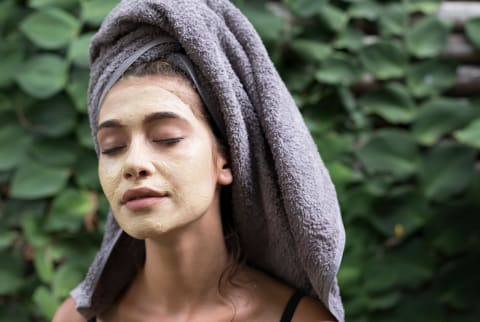Advertisement
How To Do An At-Home Facial: Step-By-Step Tips From A Celeb Esthetician


Regular facials, IMHO, are 100% worth the investment. You can splurge on the most high-quality tools and treatments you can find, but at the end of the day, there's little that can replicate expert-level hands getting up close and personal with your skin. (The massage alone is reason enough to book a session.)
That being said, facials can get pricey. Whether you go in for monthly upkeep or opt for a facial whenever the seasons change, they often do require a significant chunk of change. Again, I'm a firm believer in prioritizing professional care if it fits within your budget and lifestyle, but what if you're just craving a moment of self-care? You don't necessarily have to give your esthetician a ring whenever you'd like a spa-grade tuneup.
Yes, you should leave more invasive services to the pros (extractions, microneedling, and the like), but you can certainly give your skin some TLC from the comfort of your own home. To that end, we tapped celebrity esthetician Renée Rouleau for her essential at-home facial tips. Read on and get ready to say ahhh:
Step 1: Exfoliate.
Each esthetician has their own unique style, but every type of facial includes some type of exfoliation—a peel, a mask, a scrub, etc. After giving your skin a good cleanse (feel free to steam, too, if you’re feeling fancy), Rouleau recommends grabbing an acid-infused chemical exfoliant. "Acids lower the skin's pH to dissolve the keratin or 'glue' keeping dry, dead, and discolored cells stuck to the skin's surface," she says.
Of course, she recommends her cult-favorite Triple Berry Smoothing Peel, which comes loaded with skin-smoothing AHAs (glycolic, lactic, malic, mandelic, phytic, and tartaric acids), one PHA (gluconolactone), and antioxidant-rich fruit extracts. It looks, feels, and smells like berry jam, but you'll definitely feel those spicy acids at work when you smear it on your skin. Personally, I use this peel whenever I feel a sudden breakout rearing its head—the mask flattens those textural concerns overnight.
After you dissolve those dead skin cells, Rouleau recommends following up with a physical exfoliant, like a gentle facial scrub. Now, you might think two forms of exfoliation will be way too harsh for your complexion—and you should always know your limits if you have hypersensitive skin—but manually lifting that dead skin is key for an instantly glowing visage. "[After] dead skin cells have been loosened by your peel, a scrub will give you the lifting action you need to actually buff those cells away," explains Rouleau. "This reveals the healthy, fresh cells underneath."
That's why she recently launched her Triple Berry Smoothing Scrub (the sister product to the aforementioned peel), which calls upon gentle, biodegradable jojoba beads to buff the skin smooth while protecting the moisture barrier. "Plus it includes the same brightening, antioxidant berry blend as the peel," Rouleau adds.
Step 2: Mask.
"Step 3 is your treatment mask, and this will be different for everyone depending on your skin's needs," says Rouleau. For example, if you'd like to mitigate dryness, you might opt for a creamy, oil-based mask to feed your skin moisture and fatty acids; if congested skin is your main gripe, you might prefer a clay-based mask to further draw gunk and oil from your pores ("just make sure it's formulated with hydrating ingredients so it's not too drying," Rouleau warns). Feel free to switch up your masking step based on what your skin craves on any given day.
If you'd like to address congestion and dehydration, consider Rouleau's Rapid Response Detox Masque. "It's a gel mask, so it's soothing and hydrating without being heavy, but it also includes ingredients like tea tree oil and Manuka extract that help fight breakouts," she notes. Plus, the gel feels oh-so-cooling on freshly exfoliated skin. That's why Rouleau offers both the peel and mask in a handy little bundle.
Step 3: Treat.
After washing off your mask du jour, it's time for your treatment step. "I definitely recommend applying a serum once you've rinsed off your mask since the skin will be extra receptive to it after having been exfoliated," Rouleau advises. However, less is more: Don't layer on too many serums and oils at the end of your DIY facial. You may want to treat yourself with all the elixirs you have at your disposal, but you don't want to go overboard here.
"Your skin can only absorb so much, so stick to one serum with restorative ingredients, like peptides and antioxidants, and then top it all off with a moisturizer to seal everything in," Rouleau suggests. I adore this Tea Elixir Skin Resilience Activating Serum from fresh, or the new Kosas Plump + Juicy Vegan Collagen Spray-On Serum—both make my skin appear way more supple and pillowy.
The takeaway.
At-home facials are easier to incorporate into your routine than you think, whether you're hoping to address specific skin concerns or are simply looking for a spa-grade moment of peace. While you should get no more than one professional facial per month, DIY versions tend to be a little less intense—so feel free to add it to your weekly rotation. "If you can, doing an at-home facial once a week is a great way to give your skin a little extra love and keep it happy," adds Rouleau. "After all, when it comes to skin care, consistency is definitely key."